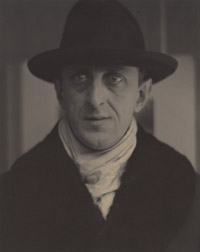Works of Art
- Filters:
- Sort by:
- Results layout:

American, 1877 - 1943
Copy-and-paste citation text:
Robert Torchia, “Marsden Hartley,” NGA Online Editions, https://purl.org/nga/collection/constituent/1375 (accessed March 25, 2025).
Export as PDF
| Version | Link |
|---|---|
| Sep 29, 2016 Version |
Marsden Hartley was born on January 4, l877, in Lewiston, Maine, to English immigrant parents. In 1893 he moved with his family to Ohio, where he studied at the Cleveland School of Art. Hartley took private lessons with John Semon, a Barbizon-style painter, and in 1898 he took a summer class with Cullen Yates, a local impressionist. Hartley excelled at the Cleveland School of Art, and a trustee provided him with financial backing to study in New York for five years. He moved to Manhattan in 1899 and attended
During the summer of 1907 in Eliot, Maine, Hartley attended a retreat for mystics called Green Acre, where he immersed himself in the study of Eastern religions. In 1908 he went to Boston and met
With the financial support of Stieglitz and
The war forced Hartley to once again sail for New York in late 1915. Soon the peripatetic artist began wandering restlessly from place to place, a habit that would characterize the next two decades of his career. Beginning in 1916 Hartley worked in, among other places, Provincetown, Massachusetts; Bermuda; Ogunquit, Maine; Taos and Santa Fe, New Mexico; and California. In 1919 he briefly affiliated himself with the avant-garde art organization founded by the American modernist
In 1937, after years of financial hardship and perceived slights, Hartley finally broke with Stieglitz after another solo exhibition, this time at An American Place, failed to produce sales. That summer he retreated, as he had so often in his youth, to Maine where he worked in a number of places before settling in Bangor. There he commenced a series of paintings of Mount Katahdin that occupied him for the next three years. In 1940, in addition to his Maine landscapes, Hartley executed a series of figure paintings that were based on sunbathers and lobstermen, as well as a group of religious subjects inspired by his time with the Mason family in Nova Scotia. During the final years of his life Hartley was plagued by failing health, and died from terminal heart failure in Ellsworth, Maine, on September 2, 1943.
A leading member of the Stieglitz group, Hartley was a pioneer American modernist whose knowledge of French avant-garde styles and close association with the innovative German painters known as Der Blaue Reiter led him to invent one of the most innovative painting styles of the early 20th century. Beginning with his return to the United States in 1915, Hartley moved away from his former abstract style and, forever moving from place to place, produced a remarkable variety of expressive landscapes, still life compositions, and unconventional portraits. His exceptionally fine late Mount Katahdin landscapes secured his legacy as one of the greatest of all American modernists.
Robert Torchia
September 29, 2016